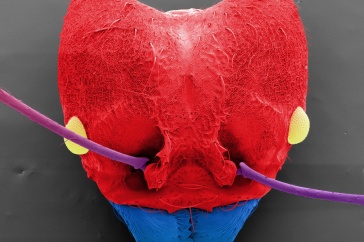
University of New Hampshire research suggests the genes of the cactus mouse may protect it from kidney damage in situations of extreme dehydration. (Photo: Courtesy)

UNH assistant professor Matt MacManes in his lab at Rudman Hall (Photo: Beth Potier)
Millions of people die every year from dehydration as a result of exposure and illness. In humans, even the most minor dehydration can compromise the kidneys, causing lifelong, irreparable issues or even death. However, some animals living in desert environments are able to survive both acute and chronic dehydration. While these animals, like cactus mice, have evolved over time to deal with environmental stressors like dehydration, researchers at the University of New Hampshire have found it’s not the physical makeup that is helping them survive, but rather their genetic makeup.
“Initially, we thought that maybe their kidneys are structurally different from people, but they’re not,” says Matt MacManes, assistant professor of genome-enabled biology at UNH and lead author of the study. “However, when exposed to acute dehydration, no kidney injury was apparent, which would definitely be the case for humans exposed to similar levels of dehydration, suggesting their genes may be what’s preventing widespread kidney damage.
“The kidney is the canary in the coalmine when it comes to dehydration,” continues MacManes. “The exciting outcome of this research is that the molecular toolkit of the cactus mouse has orthologues, or related genes, in humans. These provide the potential for development of drugs or other therapies that could help protect the human body from the damages of dehydration.” Such a response could be extremely valuable in a wide variety of situations — for people with renal failure, where water is severally limited due to geography or possibly global climate change, for troops deployed in the desert and perhaps even in space travel.
To understand how desert-adapted cactus mice (Peromyscus eremicus) survive, the study, recently published in the American Journal of Renal Physiology, outlines how the researchers modeled a desert-like condition. The mice that went without water for 72 hours lost on average 23 percent of their body weight, which would be fatal for humans. Even though dehydrated, the mice continued to be active, eat and interact normally. Researchers analyzed several other factors, including serum electrolytes (sodium, calcium, bicarbonate ion) as well as blood urea nitrogen and creatinine. While both were slightly elevated, gene-based biomarkers for kidney injury were not, which suggests kidney injury is not occurring.
Further analysis found genes that are important in modulating electrolytes were very active, as were genes responsible for maintaining kidney blood pressure.
-
Written By:
Robbin Ray ’82 | UNH Marketing | robbin.ray@unh.edu | 603-862-4864




















































